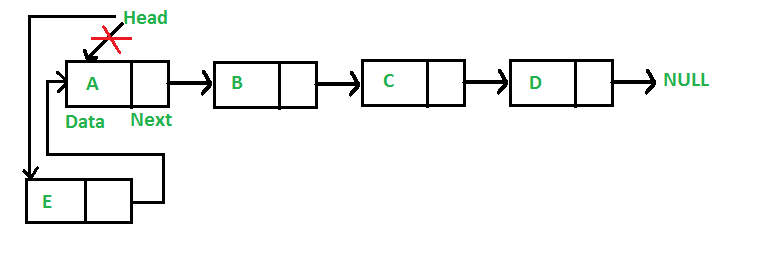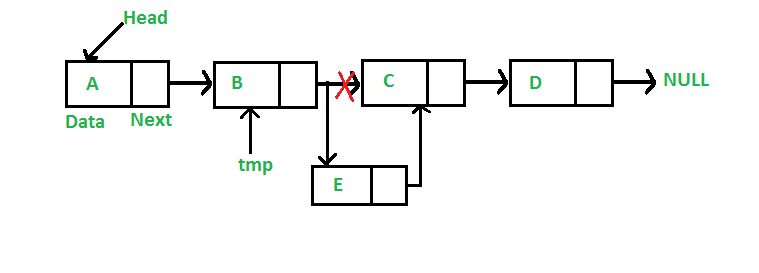用于在链表中插入节点的Python程序
我们在上一篇文章中介绍了链表。我们还创建了一个包含 3 个节点的简单链表并讨论了链表遍历。
这篇文章中讨论的所有程序都考虑了链表的以下表示。
Python
# Node class
class Node:
# Function to initialize the
# node object
def __init__(self, data):
# Assign data
self.data = data
# Initialize next as null
self.next = None
# Linked List class
class LinkedList:
# Function to initialize the
# Linked List object
def __init__(self):
self.head = NonePython
# This function is in LinkedList class
# Function to insert a new node at
# the beginning
def push(self, new_data):
# 1 & 2: Allocate the Node &
# Put in the data
new_node = Node(new_data)
# 3. Make next of new Node as head
new_node.next = self.head
# 4. Move the head to point to new Node
self.head = new_nodePython
# This function is in LinkedList class.
# Inserts a new node after the given
# prev_node. This method is defined
# inside LinkedList class shown above
def insertAfter(self, prev_node, new_data):
# 1. Check if the given prev_node exists
if prev_node is None:
print "The given previous node must in LinkedList."
return
# 2. Create new node &
# 3. Put in the data
new_node = Node(new_data)
# 4. Make next of new Node as next of prev_node
new_node.next = prev_node.next
# 5. make next of prev_node as new_node
prev_node.next = new_nodePython
# This function is defined in Linked List
# class appends a new node at the end.
# This method is defined inside LinkedList
# class shown above
def append(self, new_data):
# 1. Create a new node
# 2. Put in the data
# 3. Set next as None
new_node = Node(new_data)
# 4. If the Linked List is empty, then
# make the new node as head
if self.head is None:
self.head = new_node
return
# 5. Else traverse till the last node
last = self.head
while (last.next):
last = last.next
# 6. Change the next of last node
last.next = new_nodePython
# A complete working Python program to demonstrate all
# insertion methods of linked list
# Node class
class Node:
# Function to initialize the
# node object
def __init__(self, data):
# Assign data
self.data = data
# Initialize next as null
self.next = None
# Linked List class contains a
# Node object
class LinkedList:
# Function to initialize head
def __init__(self):
self.head = None
# Functio to insert a new node at
# the beginning
def push(self, new_data):
# 1 & 2: Allocate the Node &
# Put in the data
new_node = Node(new_data)
# 3. Make next of new Node as head
new_node.next = self.head
# 4. Move the head to point to new Node
self.head = new_node
# This function is in LinkedList class.
# Inserts a new node after the given
# prev_node. This method is defined
# inside LinkedList class shown above
def insertAfter(self, prev_node, new_data):
# 1. Check if the given prev_node exists
if prev_node is None:
print "The given previous node must inLinkedList."
return
# 2. Create new node &
# Put in the data
new_node = Node(new_data)
# 4. Make next of new Node as next
# of prev_node
new_node.next = prev_node.next
# 5. make next of prev_node as new_node
prev_node.next = new_node
# This function is defined in Linked List class
# Appends a new node at the end. This method is
# defined inside LinkedList class shown above */
def append(self, new_data):
# 1. Create a new node
# 2. Put in the data
# 3. Set next as None
new_node = Node(new_data)
# 4. If the Linked List is empty, then make the
# new node as head
if self.head is None:
self.head = new_node
return
# 5. Else traverse till the last node
last = self.head
while (last.next):
last = last.next
# 6. Change the next of last node
last.next = new_node
# Utility function to print the
# linked list
def printList(self):
temp = self.head
while (temp):
print temp.data,
temp = temp.next
# Code execution starts here
if __name__=='__main__':
# Start with the empty list
llist = LinkedList()
# Insert 6. So linked list
becomes 6->None
llist.append(6)
# Insert 7 at the beginning. So
# linked list becomes 7->6->None
llist.push(7);
# Insert 1 at the beginning. So
# linked list becomes 1->7->6->None
llist.push(1);
# Insert 4 at the end. So linked list
# becomes 1->7->6->4->None
llist.append(4)
# Insert 8, after 7. So linked list
# becomes 1 -> 7-> 8-> 6-> 4-> None
llist.insertAfter(llist.head.next, 8)
print 'Created linked list is:',
llist.printList()
# This code is contributed by Manikantan Narasimhan在这篇文章中,讨论了在链表中插入新节点的方法。可以通过三种方式添加节点
1)在链表的前面
2)在给定节点之后。
3)在链表的末尾。
在前面添加一个节点:(4步过程)
新节点总是添加在给定链表的头部之前。新添加的节点成为链表的新头。例如,如果给定的链表是 10->15->20->25,我们在前面添加一个项目 5,那么链表变为 5->10->15->20->25。让我们将添加到列表前面的函数称为 push()。 push() 必须接收指向头指针的指针,因为 push 必须更改头指针以指向新节点(请参阅this)

以下是在前面添加节点的 4 个步骤。
Python
# This function is in LinkedList class
# Function to insert a new node at
# the beginning
def push(self, new_data):
# 1 & 2: Allocate the Node &
# Put in the data
new_node = Node(new_data)
# 3. Make next of new Node as head
new_node.next = self.head
# 4. Move the head to point to new Node
self.head = new_node
push() 的时间复杂度是 O(1),因为它做的工作量是恒定的。
在给定节点之后添加一个节点:(5个步骤)
我们得到一个指向节点的指针,新节点插入到给定节点之后。

Python
# This function is in LinkedList class.
# Inserts a new node after the given
# prev_node. This method is defined
# inside LinkedList class shown above
def insertAfter(self, prev_node, new_data):
# 1. Check if the given prev_node exists
if prev_node is None:
print "The given previous node must in LinkedList."
return
# 2. Create new node &
# 3. Put in the data
new_node = Node(new_data)
# 4. Make next of new Node as next of prev_node
new_node.next = prev_node.next
# 5. make next of prev_node as new_node
prev_node.next = new_node
insertAfter() 的时间复杂度是 O(1),因为它做的工作量是恒定的。
最后添加一个节点:(6步过程)
新节点总是添加在给定链表的最后一个节点之后。例如,如果给定的链表是 5->10->15->20->25 并且我们在末尾添加了一个项目 30,那么链表变为 5->10->15->20->25- >30。
由于链接列表通常由其头部表示,因此我们必须遍历列表直到最后,然后将倒数第二个节点更改为新节点。

以下是最后添加节点的 6 个步骤。
Python
# This function is defined in Linked List
# class appends a new node at the end.
# This method is defined inside LinkedList
# class shown above
def append(self, new_data):
# 1. Create a new node
# 2. Put in the data
# 3. Set next as None
new_node = Node(new_data)
# 4. If the Linked List is empty, then
# make the new node as head
if self.head is None:
self.head = new_node
return
# 5. Else traverse till the last node
last = self.head
while (last.next):
last = last.next
# 6. Change the next of last node
last.next = new_node
追加的时间复杂度是 O(n),其中 n 是链表中的节点数。由于从头到尾有一个循环,因此该函数执行 O(n) 工作。
通过保留一个指向链表尾部的额外指针,还可以优化此方法以在 O(1) 中工作/
下面是一个完整的程序,它使用上述所有方法来创建一个链表。
Python
# A complete working Python program to demonstrate all
# insertion methods of linked list
# Node class
class Node:
# Function to initialize the
# node object
def __init__(self, data):
# Assign data
self.data = data
# Initialize next as null
self.next = None
# Linked List class contains a
# Node object
class LinkedList:
# Function to initialize head
def __init__(self):
self.head = None
# Functio to insert a new node at
# the beginning
def push(self, new_data):
# 1 & 2: Allocate the Node &
# Put in the data
new_node = Node(new_data)
# 3. Make next of new Node as head
new_node.next = self.head
# 4. Move the head to point to new Node
self.head = new_node
# This function is in LinkedList class.
# Inserts a new node after the given
# prev_node. This method is defined
# inside LinkedList class shown above
def insertAfter(self, prev_node, new_data):
# 1. Check if the given prev_node exists
if prev_node is None:
print "The given previous node must inLinkedList."
return
# 2. Create new node &
# Put in the data
new_node = Node(new_data)
# 4. Make next of new Node as next
# of prev_node
new_node.next = prev_node.next
# 5. make next of prev_node as new_node
prev_node.next = new_node
# This function is defined in Linked List class
# Appends a new node at the end. This method is
# defined inside LinkedList class shown above */
def append(self, new_data):
# 1. Create a new node
# 2. Put in the data
# 3. Set next as None
new_node = Node(new_data)
# 4. If the Linked List is empty, then make the
# new node as head
if self.head is None:
self.head = new_node
return
# 5. Else traverse till the last node
last = self.head
while (last.next):
last = last.next
# 6. Change the next of last node
last.next = new_node
# Utility function to print the
# linked list
def printList(self):
temp = self.head
while (temp):
print temp.data,
temp = temp.next
# Code execution starts here
if __name__=='__main__':
# Start with the empty list
llist = LinkedList()
# Insert 6. So linked list
becomes 6->None
llist.append(6)
# Insert 7 at the beginning. So
# linked list becomes 7->6->None
llist.push(7);
# Insert 1 at the beginning. So
# linked list becomes 1->7->6->None
llist.push(1);
# Insert 4 at the end. So linked list
# becomes 1->7->6->4->None
llist.append(4)
# Insert 8, after 7. So linked list
# becomes 1 -> 7-> 8-> 6-> 4-> None
llist.insertAfter(llist.head.next, 8)
print 'Created linked list is:',
llist.printList()
# This code is contributed by Manikantan Narasimhan
输出:
Created Linked list is: 1 7 8 6 4请参阅链表上的完整文章 |设置 2(插入节点)了解更多详情!